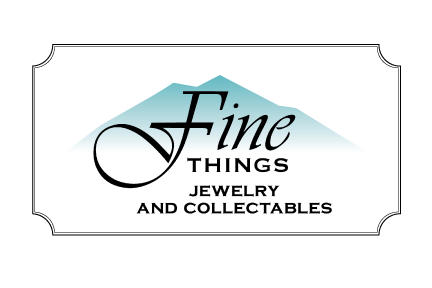Moonstone
Moonstone is the best-known gem of the feldspar group of minerals. It is also a birthstone for June along with Pearl and Alexandrite. It is renowned for its adularescence, the light that appears to billow across a gemstone, giving it a special glow. A ghostly sheen moves under the surface, like moonlight glowing in water. The finest moonstones show a blue sheen against a colorless background.
Feldspar is prized for its billowy blue adularescence, caused by light scattering from an intergrowth of microscopic, alternating layers. It’s also a favored gem of many Art Nouveau jewelry designers.
Definition:
Moonstone’s delicate beauty and its long-established heritage make it perhaps the most familiar gem in the feldspar group. Feldspars are the most widespread minerals in the earth’s crust, as well as some of the most diverse. You can pick up a rock anywhere in the world, and you’ll probably find that it contains a mineral or two from the feldspar group.
Moonstone is a variety of the mineral orthoclase. It’s composed of two feldspar minerals, orthoclase and albite. At first, the two minerals are intermingled. Then, as the newly formed mineral cools, the inter-grown orthoclase and albite
separate into stacked, alternating layers.
When light falls between these thin, flat layers, it scatters in many directions, producing the phenomenon called adularescence. Adularescence is the light that appears to billow across a gemstone, giving its surface a glowing appearance. Perhaps the most captivating aspect of adularescence is its appearance of motion. The misty light seems to roll across the gem’s surface as you change the viewing image.
A variety of labradorite is sometimes called rainbow moonstone. Sanidine is another feldspar mineral that can include adularescent gems called moonstones. To be called moonstone, a mineral’s actual identity is not as important as the beauty of its adularescence.

The History of Moonstone:
This June Birthstone has been associated with both the Roman and Greek lunar deities. Hindu mythology claims that it is made of solidified moonbeams. Many other cultures also associated this gemstone with moonlight. Its visual effect, or adularescence, is reminiscent of the full moon shining through a veil of high, thin clouds. Many believe that you could see the future if you held a moonstone in your mouth during a full moon.
Adularescent Moonstone was once called “adularia”. The name originated with a city in Switzerland, Mt. Adular (now St. Gotthard), that was one of the first sources of fine quality moonstone.
Great designers of the Art Nouveau era (1890s to 1910s), such as Rene’ Lalique and Louis Comfort Tiffany, featured moonstone in their fine jewelry. The moonstone birthstone came to the forefront again during the 1960s “flower child” movement, where designers used it in handcrafted silver jewelry, and again with New Age designers of the 1990s.
Symbolism:
Moonstone is often associated with love, passion, intuition and fertility and is believed to bring great luck. Moonstone has traditionally been used to enhance psychic abilities and to develop clairvoyance. Psychologically, Moonstone calms overreactions to situations and to emotional triggers. It is filled with receptive, passive, feminine energy. It balances Male-female energies and aids men who want to get in touch with their feminine side. It is the perfect anecdote for the excessively macho man or overly aggressive female.
Mentally, Moonstone soothes emotional instability and stress, and stabilizes the emotions. It improves emotional intelligence. Placed on the solar plexus, it draws out old emotional patterning so that it can be understood and then dissolved. Moonstone provides deep emotional healing and heals disorders of the upper digestive tract that are related to emotional stress.
Physically, Moonstone powerfully affects the female reproductive cycle and alleviates menstrual-related tensions. It is linked to the pineal gland and balances the hormonal system, stabilizes fluid imbalances, and attunes to the biorhythmic clock. It is helpful in cases of shock and can be used to calm hyperactive children.
Tamil Nadu state of Southern India
Location:
The birthstone for June can be found in a wide variety of places. This includes parts of the United States, such as New Mexico, North Carolina and Virginia. The most important world locations for moonstone are India and Sri Lanka, but other sources include Brazil, Madagascar, Myanmar and Tanzania.
Other feldspar minerals can also show adularescence including labradorite and sanidine. Labradorite feldspar is found mainly in Labrador, Canada. Another labradorite—found in Madagascar—has a multicolored adularescence over a light bodycolor. It’s known in the trade as rainbow moonstone, despite the fact that it’s actually a variety of labradorite rather than orthoclase.
Care & Cleaning:
Moonstone is a 6 to 6.5 on the Mohs Scale of Hardness and has poor toughness. It may crack when exposed to high heat. Therefore, ultrasonic and steam cleaners should not be used on your moonstone. The best option for cleaning is warm, soapy water with a soft brush.
Why We Love This Gemstone
Rarity:
Rare in top qualities, this ethereal gem derives from one of the earth’s most common minerals.
Adularescence:
Stacked layers of orthoclase and albite diffract light, creating moonstone’s adularescence.
Phenomena:
Besides adularescence, moonstone sometimes also shows a cat’s-eye effect.
COLOR
The finest moonstone is a gem of glassy purity with a mobile, electric blue shimmer.
CLARITY
Characteristic inclusions include tiny tension cracks called centipedes.
CUT
As it displays moonstone’s phenomena to best advantage, cabochon is the common cut.
CARAT
Moonstone comes in a wide range of sizes and carat weights.


